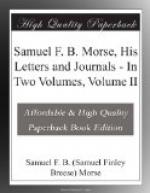In September he returned with his wife, his daughter, and his youngest son to Paris, leaving his two older sons with their tutor in Geneva. As he wished to make Paris his headquarters for nearly a year, he sought and found a furnished apartment at No. 10 Avenue du Roi de Rome (now the Avenue du Trocadero), and he writes to his mother-in-law on September 22: “We are fortunate in having apartments in a new building, or rather one newly and completely repaired throughout. All the apartments are newly furnished with elegant furniture, we having the first use of it. We have ample rooms, not large, but promising more comfort for winter residence than if they were larger. The situation is on a wide avenue and central for many purposes; close to the Champs Elysees, near also to the Bois de Boulogne, and within a few minutes walk of the Champ de Mars, so that we shall be most eligibly situated to visit the great Exposition when it opens in April.”
His wife’s sister, Mrs. Goodrich, with her husband and daughters, occupied an apartment in the same building; his grandson Charles Lind was also in Paris studying painting, and before the summer of the next year other members of his family came to Paris, so that at one time eighteen of those related to him by blood or marriage were around him. To a man of Morse’s affectionate nature and loyalty to family this was a source of peculiar joy, and those Parisian days were some of the happiest of his life. The rest of the autumn and early winter were spent in sight-seeing and in settling his children in their various studies.
The brilliance of the court of Napoleon III just before the debacle of 1870 is a matter of history, and it reached its high-water mark during the Exposition year of 1867, when emperors, kings, and princes journeyed to Paris to do homage to the man of the hour. Court balls, receptions, gala performances at opera and theatre, and military reviews followed each other in bewildering but well-ordered confusion, and Morse, as a man of worldwide celebrity, took part in all of them. He and his wife and his young daughter, a girl of sixteen, were presented at court, and were feted everywhere. In a letter to his mother-in-law he gives a description of his court costume on the occasion of his first presentation, when he was accompanied only by his brother-in-law, Mr. Goodrich:—
“We received our cards inviting us to the soiree and to pass the evening with their majesties on the 16th of January (Wednesday evening). ’En uniforme’ was stamped upon the card, so we had to procure court dresses. Mr. Goodrich, as is the custom in most cases, hired his; I had a full suit made for me. A chapeau bras, with gold lace loop, a blue coat, with standing collar, single breasted, richly embroidered with gold lace, the American eagle button, white silk lining, vest light cashmere with gilt buttons, pantaloons with a broad stripe of gold lace on the outside seams,




